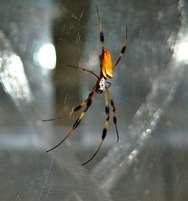Untangling the mysteries of spider silk

Spiders weave a web even more tangled than originally thought – at least on the nanoscale level, according to a new study performed at the U.S. Department of Energy’s (DOE) Argonne National Laboratory.
Using high-energy X-rays provided by Argonne’s Advanced Photon Source (APS), scientists peered into the structure of orb spiders’ dragline silk. This is the chief thread that allows them to dangle precipitously off branches and window frames.
“Spider silk has a unique combination of mechanical strength and elasticity that make it one of the toughest materials we know,” said Professor Jeffery Yarger of Arizona State University, one of the lead researchers of the study.
The inner core of dragline silk is made up of a set of tiny fibers called fibrils, which, at the atomic level, organize into two different regions. The incredible strength of the material comes from crystalline lattices that compose roughly ten percent of the total webbing, while its elasticity is the result of so-called “amorphous” regions that make up the remaining 90 percent.
Argonne X-ray scientist Chris Benmore developed an experiment to probe the nano-crystalline structure of dragline spider silk. According to Benmore, previous studies of spider silk focused on the crystalline regions because their structures were easier to image. “In this study, we focused on getting a good view of the amorphous areas, which is something you really need a machine like the APS for,” Benmore explained.
Unlike the crystalline areas, which tend to arrange themselves in predictable, repeating patterns, the atoms in the amorphous parts of dragline silk lost their ordering after about a nanometer. “It’s not terribly surprising, given that the amorphous regions are made up of all these proteins that are incredibly complicated,” Benmore said.
By getting a better picture of the relationship between the amorphous and crystalline structure of natural silks, Yarger and Benmore hope to provide the grounds for an improved set of models and simulations that could improve the fabrication of a whole class of synthetic materials.
Artificial spider silk production is the ultimate goal of the study, and collaborator Randall Lewis at Utah State University recently achieved success on this front using X-rays and NMR techniques combined with mechanical testing. Lewis found that synthetic silk resembled the natural fibers much more after water treatment.
“When it comes to silks, humans are just so far behind nature in terms of the quality of the materials that we can produce,” said Lewis. “We think this research will give us a benchmark that we can use to create materials that could translate to the marketplace.”
The study on natural spider silks, “Total X-ray Scattering Of Spider Dragline Silk”, was published in Physical Review Letters and highlighted as an “Editors’ Suggestion.” The study on artificial silks, “Combining Flagelliform and Dragline Spider Silk Motif to Produce Tunable Synthetic Biopolymer Fibers", was published in Biopolymers.
More information: Phys. Rev. Lett. 108, 178102 (2012) DOI: 10.1103/PhysRevLett.108.178102
Journal information: Physical Review Letters
Provided by Argonne National Laboratory



















